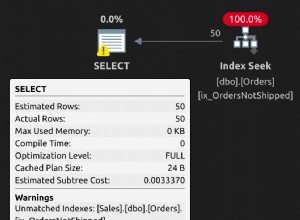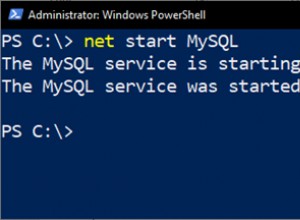Introdução
Geralmente, é o caso quando uma transação do MS SQL Server está sendo esquecida pelo iniciador. O melhor exemplo seria o seguinte:é executado um script no SSMS que, através da instrução ‘begin tran’, inicia uma transação e ocorre um erro; no entanto, 'commit' ou 'rollback' não são executados e o iniciador de execução deixou essa consulta por um longo tempo. Como resultado, mais e mais flutuações aparecem quando se trata de bloquear as consultas que solicitam acesso a recursos fechados (tabelas e recursos do servidor, como RAM, CPU e sistema de entrada-saída).
Neste artigo, veremos uma das maneiras de automatizar o processo de exclusão de transações esquecidas.
A solução
Vamos definir uma transação esquecida como uma transação ativa (executada atualmente) que, durante um intervalo de tempo suficientemente grande T, não possui consultas ativas (executadas atualmente).
Aqui está o algoritmo geral para excluir essas transações:
- Criar uma tabela para armazenar e analisar informações sobre transações atualmente esquecidas, bem como uma tabela para classificar e arquivar as transações selecionadas da primeira tabela por ações de exclusão.
- Coleta de informações (transações e suas sessões que não possuem consultas, ou seja, as transações que foram executadas e esquecidas dentro de um determinado intervalo de tempo T.
- Atualizando a tabela contendo todas as transações esquecidas que recebemos na etapa 1 (se uma transação esquecida tiver adquirido uma consulta ativa, essa transação será excluída desta tabela).
- Recuperando as sessões que precisamos matar (uma sessão tem pelo menos uma transação que foi colocada como esquecida na tabela da etapa 1 K ou mais vezes e a sessão teve uma consulta ativa ausente na mesma quantidade de vezes). l>
- Arquivando os dados que vamos excluir (detalhes sobre as sessões, conexões e transações que serão eliminadas).
- Excluindo as sessões selecionadas.
- Excluindo as entradas processadas junto com aquelas que não podem ser removidas e que estão na tabela desde a etapa 1 há muito tempo.
Agora, vamos ver como podemos implementar esse algoritmo.
Primeiro, precisamos criar uma tabela para armazenar e analisar as informações sobre todas as transações atualmente esquecidas:
USE [DB_NAME] GO SET ANSI_NULLS ON GO SET QUOTED_IDENTIFIER ON GO CREATE TABLE [srv].[SessionTran]( [SessionID] [int] NOT NULL, [TransactionID] [bigint] NOT NULL, [CountTranNotRequest] [tinyint] NOT NULL, [CountSessionNotRequest] [tinyint] NOT NULL, [TransactionBeginTime] [datetime] NOT NULL, [InsertUTCDate] [datetime] NOT NULL, [UpdateUTCDate] [datetime] NOT NULL, CONSTRAINT [PK_SessionTran] PRIMARY KEY CLUSTERED ( [SessionID] ASC, [TransactionID] ASC )WITH (PAD_INDEX = OFF, STATISTICS_NORECOMPUTE = OFF, IGNORE_DUP_KEY = OFF, ALLOW_ROW_LOCKS = ON, ALLOW_PAGE_LOCKS = ON) ON [PRIMARY] ) ON [PRIMARY] GO ALTER TABLE [srv].[SessionTran] ADD CONSTRAINT [DF_SessionTran_Count] DEFAULT ((0)) FOR [CountTranNotRequest] GO ALTER TABLE [srv].[SessionTran] ADD CONSTRAINT [DF_SessionTran_CountSessionNotRequest] DEFAULT ((0)) FOR [CountSessionNotRequest] GO ALTER TABLE [srv].[SessionTran] ADD CONSTRAINT [DF_SessionTran_InsertUTCDate] DEFAULT (getutcdate()) FOR [InsertUTCDate] GO ALTER TABLE [srv].[SessionTran] ADD CONSTRAINT [DF_SessionTran_UpdateUTCDate] DEFAULT (getutcdate()) FOR [UpdateUTCDate] GO
Aqui:
1) SessionID — identificador de sessão
2) TransactionID — identificador de transação esquecido
3) CountTranNotRequest — a quantidade de vezes que uma transação foi registrada como esquecida
4) CountSessionNotRequest — a quantidade de vezes que uma sessão sem consultas ativas foi registrado e teve uma transação esquecida
5) TransactionBeginTime — data e hora do início da transação esquecida
6) InsertUTCDate — data e hora da criação da entrada (UTC)
7) UpdateUTCDate — data e hora da atualização de entrada (UTC)
Em seguida, criaremos uma tabela para arquivar e classificar as transações da primeira tabela por ações de exclusão:
[expandir título ="Código “]
USE [DB_NAME] GO SET ANSI_NULLS ON GO SET QUOTED_IDENTIFIER ON GO CREATE TABLE [srv].[KillSession]( [ID] [int] IDENTITY(1,1) NOT NULL, [session_id] [smallint] NOT NULL, [transaction_id] [bigint] NOT NULL, [login_time] [datetime] NOT NULL, [host_name] [nvarchar](128) NULL, [program_name] [nvarchar](128) NULL, [host_process_id] [int] NULL, [client_version] [int] NULL, [client_interface_name] [nvarchar](32) NULL, [security_id] [varbinary](85) NOT NULL, [login_name] [nvarchar](128) NOT NULL, [nt_domain] [nvarchar](128) NULL, [nt_user_name] [nvarchar](128) NULL, [status] [nvarchar](30) NOT NULL, [context_info] [varbinary](128) NULL, [cpu_time] [int] NOT NULL, [memory_usage] [int] NOT NULL, [total_scheduled_time] [int] NOT NULL, [total_elapsed_time] [int] NOT NULL, [endpoint_id] [int] NOT NULL, [last_request_start_time] [datetime] NOT NULL, [last_request_end_time] [datetime] NULL, [reads] [bigint] NOT NULL, [writes] [bigint] NOT NULL, [logical_reads] [bigint] NOT NULL, [is_user_process] [bit] NOT NULL, [text_size] [int] NOT NULL, [language] [nvarchar](128) NULL, [date_format] [nvarchar](3) NULL, [date_first] [smallint] NOT NULL, [quoted_identifier] [bit] NOT NULL, [arithabort] [bit] NOT NULL, [ansi_null_dflt_on] [bit] NOT NULL, [ansi_defaults] [bit] NOT NULL, [ansi_warnings] [bit] NOT NULL, [ansi_padding] [bit] NOT NULL, [ansi_nulls] [bit] NOT NULL, [concat_null_yields_null] [bit] NOT NULL, [transaction_isolation_level] [smallint] NOT NULL, [lock_timeout] [int] NOT NULL, [deadlock_priority] [int] NOT NULL, [row_count] [bigint] NOT NULL, [prev_error] [int] NOT NULL, [original_security_id] [varbinary](85) NOT NULL, [original_login_name] [nvarchar](128) NOT NULL, [last_successful_logon] [datetime] NULL, [last_unsuccessful_logon] [datetime] NULL, [unsuccessful_logons] [bigint] NULL, [group_id] [int] NOT NULL, [database_id] [smallint] NOT NULL, [authenticating_database_id] [int] NULL, [open_transaction_count] [int] NOT NULL, [most_recent_session_id] [int] NULL, [connect_time] [datetime] NULL, [net_transport] [nvarchar](40) NULL, [protocol_type] [nvarchar](40) NULL, [protocol_version] [int] NULL, [encrypt_option] [nvarchar](40) NULL, [auth_scheme] [nvarchar](40) NULL, [node_affinity] [smallint] NULL, [num_reads] [int] NULL, [num_writes] [int] NULL, [last_read] [datetime] NULL, [last_write] [datetime] NULL, [net_packet_size] [int] NULL, [client_net_address] [nvarchar](48) NULL, [client_tcp_port] [int] NULL, [local_net_address] [nvarchar](48) NULL, [local_tcp_port] [int] NULL, [connection_id] [uniqueidentifier] NULL, [parent_connection_id] [uniqueidentifier] NULL, [most_recent_sql_handle] [varbinary](64) NULL, [LastTSQL] [nvarchar](max) NULL, [transaction_begin_time] [datetime] NOT NULL, [CountTranNotRequest] [tinyint] NOT NULL, [CountSessionNotRequest] [tinyint] NOT NULL, [InsertUTCDate] [datetime] NOT NULL, CONSTRAINT [PK_KillSession] PRIMARY KEY CLUSTERED ( [ID] ASC )WITH (PAD_INDEX = OFF, STATISTICS_NORECOMPUTE = OFF, IGNORE_DUP_KEY = OFF, ALLOW_ROW_LOCKS = ON, ALLOW_PAGE_LOCKS = ON) ON [PRIMARY] ) ON [PRIMARY] TEXTIMAGE_ON [PRIMARY] GO ALTER TABLE [srv].[KillSession] ADD CONSTRAINT [DF_KillSession_InsertUTCDate] DEFAULT (getutcdate()) FOR [InsertUTCDate] GO
[/expandir]
Aqui, todos os campos são obtidos das representações do sistema 'sys.dm_exec_sessions' e 'sys.dm_exec_connections', e 'InsertUTCDate' especifica a hora UTC em que a entrada foi criada.
Em seguida, para concluir as etapas restantes, vamos implementar o procedimento armazenado [srv].[AutoKillSessionTranBegin] da seguinte maneira:
[expandir título ="Código “]
USE [DB_NAME]
GO
SET ANSI_NULLS ON
GO
SET QUOTED_IDENTIFIER ON
GO
CREATE PROCEDURE [srv].[AutoKillSessionTranBegin]
@minuteOld int, --age of the executed transaction (T min.)
@countIsNotRequests int --amount of times it has been placed into the table (K)
AS
BEGIN
SET NOCOUNT ON;
SET TRANSACTION ISOLATION LEVEL READ UNCOMMITTED;
declare @tbl table (
SessionID int,
TransactionID bigint,
IsSessionNotRequest bit,
TransactionBeginTime datetime
);
--retrieving information (transactions and theirs session which have no requests, i.e, transactions that were initiated and forgotten)
insert into @tbl (
SessionID,
TransactionID,
IsSessionNotRequest,
TransactionBeginTime
)
select t.[session_id] as SessionID
, t.[transaction_id] as TransactionID
, case when exists(select top(1) 1 from sys.dm_exec_requests as r where r.[session_id]=t.[session_id]) then 0 else 1 end as IsSessionNotRequest
, (select top(1) ta.[transaction_begin_time] from sys.dm_tran_active_transactions as ta where ta.[transaction_id]=t.[transaction_id]) as TransactionBeginTime
from sys.dm_tran_session_transactions as t
where t.[is_user_transaction]=1
and not exists(select top(1) 1 from sys.dm_exec_requests as r where r.[transaction_id]=t.[transaction_id]);
--refreshing the table containing all initiated transactions with no requests
;merge srv.SessionTran as st
using @tbl as t
on st.[SessionID]=t.[SessionID] and st.[TransactionID]=t.[TransactionID]
when matched then
update set [UpdateUTCDate] = getUTCDate()
, [CountTranNotRequest] = st.[CountTranNotRequest]+1
, [CountSessionNotRequest] = case when (t.[IsSessionNotRequest]=1) then (st.[CountSessionNotRequest]+1) else 0 end
, [TransactionBeginTime] = t.[TransactionBeginTime]
when not matched by target then
insert (
[SessionID]
,[TransactionID]
,[TransactionBeginTime]
)
values (
t.[SessionID]
,t.[TransactionID]
,t.[TransactionBeginTime]
)
when not matched by source then delete;
--list of sessions which need to be deleted (those that contain forgotten transactions)
declare @kills table (
SessionID int
);
--детальная информация для архива
declare @kills_copy table (
SessionID int,
TransactionID bigint,
CountTranNotRequest tinyint,
CountSessionNotRequest tinyint,
TransactionBeginTime datetime
)
--gathering the sessions we need to kill
--a session has at least one transaction which was marked as having no requests @countIsNotRequests times
--and this session was marked as having no active requests the same amount of times
insert into @kills_copy (
SessionID,
TransactionID,
CountTranNotRequest,
CountSessionNotRequest,
TransactionBeginTime
)
select SessionID,
TransactionID,
CountTranNotRequest,
CountSessionNotRequest,
TransactionBeginTime
from srv.SessionTran
where [CountTranNotRequest]>[email protected]
and [CountSessionNotRequest]>[email protected]
and [TransactionBeginTime]<=DateAdd(minute,[email protected],GetDate());
--archiving the data we need to delete (details on the sessions to be deleted, connections and transactions)
INSERT INTO [srv].[KillSession]
([session_id]
,[transaction_id]
,[login_time]
,[host_name]
,[program_name]
,[host_process_id]
,[client_version]
,[client_interface_name]
,[security_id]
,[login_name]
,[nt_domain]
,[nt_user_name]
,[status]
,[context_info]
,[cpu_time]
,[memory_usage]
,[total_scheduled_time]
,[total_elapsed_time]
,[endpoint_id]
,[last_request_start_time]
,[last_request_end_time]
,[reads]
,[writes]
,[logical_reads]
,[is_user_process]
,[text_size]
,[language]
,[date_format]
,[date_first]
,[quoted_identifier]
,[arithabort]
,[ansi_null_dflt_on]
,[ansi_defaults]
,[ansi_warnings]
,[ansi_padding]
,[ansi_nulls]
,[concat_null_yields_null]
,[transaction_isolation_level]
,[lock_timeout]
,[deadlock_priority]
,[row_count]
,[prev_error]
,[original_security_id]
,[original_login_name]
,[last_successful_logon]
,[last_unsuccessful_logon]
,[unsuccessful_logons]
,[group_id]
,[database_id]
,[authenticating_database_id]
,[open_transaction_count]
,[most_recent_session_id]
,[connect_time]
,[net_transport]
,[protocol_type]
,[protocol_version]
,[encrypt_option]
,[auth_scheme]
,[node_affinity]
,[num_reads]
,[num_writes]
,[last_read]
,[last_write]
,[net_packet_size]
,[client_net_address]
,[client_tcp_port]
,[local_net_address]
,[local_tcp_port]
,[connection_id]
,[parent_connection_id]
,[most_recent_sql_handle]
,[LastTSQL]
,[transaction_begin_time]
,[CountTranNotRequest]
,[CountSessionNotRequest])
select ES.[session_id]
,kc.[TransactionID]
,ES.[login_time]
,ES.[host_name]
,ES.[program_name]
,ES.[host_process_id]
,ES.[client_version]
,ES.[client_interface_name]
,ES.[security_id]
,ES.[login_name]
,ES.[nt_domain]
,ES.[nt_user_name]
,ES.[status]
,ES.[context_info]
,ES.[cpu_time]
,ES.[memory_usage]
,ES.[total_scheduled_time]
,ES.[total_elapsed_time]
,ES.[endpoint_id]
,ES.[last_request_start_time]
,ES.[last_request_end_time]
,ES.[reads]
,ES.[writes]
,ES.[logical_reads]
,ES.[is_user_process]
,ES.[text_size]
,ES.[language]
,ES.[date_format]
,ES.[date_first]
,ES.[quoted_identifier]
,ES.[arithabort]
,ES.[ansi_null_dflt_on]
,ES.[ansi_defaults]
,ES.[ansi_warnings]
,ES.[ansi_padding]
,ES.[ansi_nulls]
,ES.[concat_null_yields_null]
,ES.[transaction_isolation_level]
,ES.[lock_timeout]
,ES.[deadlock_priority]
,ES.[row_count]
,ES.[prev_error]
,ES.[original_security_id]
,ES.[original_login_name]
,ES.[last_successful_logon]
,ES.[last_unsuccessful_logon]
,ES.[unsuccessful_logons]
,ES.[group_id]
,ES.[database_id]
,ES.[authenticating_database_id]
,ES.[open_transaction_count]
,EC.[most_recent_session_id]
,EC.[connect_time]
,EC.[net_transport]
,EC.[protocol_type]
,EC.[protocol_version]
,EC.[encrypt_option]
,EC.[auth_scheme]
,EC.[node_affinity]
,EC.[num_reads]
,EC.[num_writes]
,EC.[last_read]
,EC.[last_write]
,EC.[net_packet_size]
,EC.[client_net_address]
,EC.[client_tcp_port]
,EC.[local_net_address]
,EC.[local_tcp_port]
,EC.[connection_id]
,EC.[parent_connection_id]
,EC.[most_recent_sql_handle]
,(select top(1) text from sys.dm_exec_sql_text(EC.[most_recent_sql_handle])) as [LastTSQL]
,kc.[TransactionBeginTime]
,kc.[CountTranNotRequest]
,kc.[CountSessionNotRequest]
from @kills_copy as kc
inner join sys.dm_exec_sessions ES with(readuncommitted) on kc.[SessionID]=ES.[session_id]
inner join sys.dm_exec_connections EC with(readuncommitted) on EC.session_id = ES.session_id;
--gathering sessions
insert into @kills (
SessionID
)
select [SessionID]
from @kills_copy
group by [SessionID];
declare @SessionID int;
--deleting sessions
while(exists(select top(1) 1 from @kills))
begin
select top(1)
@SessionID=[SessionID]
from @kills;
BEGIN TRY
EXEC sp_executesql N'kill @SessionID',
N'@SessionID INT',
@SessionID;
END TRY
BEGIN CATCH
END CATCH
delete from @kills
where [SessionID][email protected];
end
select st.[SessionID]
,st.[TransactionID]
into #tbl
from srv.SessionTran as st
where st.[CountTranNotRequest]>=250
or st.[CountSessionNotRequest]>=250
or exists(select top(1) 1 from @kills_copy kc where kc.[SessionID]=st.[SessionID]);
--Deleting the processed entries along with those that cannot be removed and have been in the table for too long
delete from st
from #tbl as t
inner join srv.SessionTran as st on t.[SessionID] =st.[SessionID]
and t.[TransactionID]=st.[TransactionID];
drop table #tbl;
END
GO [/expandir]
A etapa 7 do algoritmo é implementada por meio de um desses dois contadores – CountTranNotRequest ou CountSessionNotRequest – atingindo um valor de 250.
O resultado
Neste artigo, analisamos a implementação de um processo que exclui automaticamente as transações esquecidas.
Este método nos permite automatizar o processo de exclusão de transações esquecidas. Isso resulta em diminuir ou parar o crescimento da flutuação no bloqueio produzido por tais transações. Assim, o desempenho do SGBD é protegido das ações que podem resultar em transações esquecidas.
Fontes:
» sys.dm_exec_requests
» sys.dm_tran_active_transactions
» sys.dm_tran_session_transactions
» sys.dm_exec_sql_text
» sys.dm_exec_sessions
» sys.dm_exec_connections
» KILL




